2013 Peugeot 3008 Hybrid 4 tow
[x] Cancel search: towPage 144 of 340
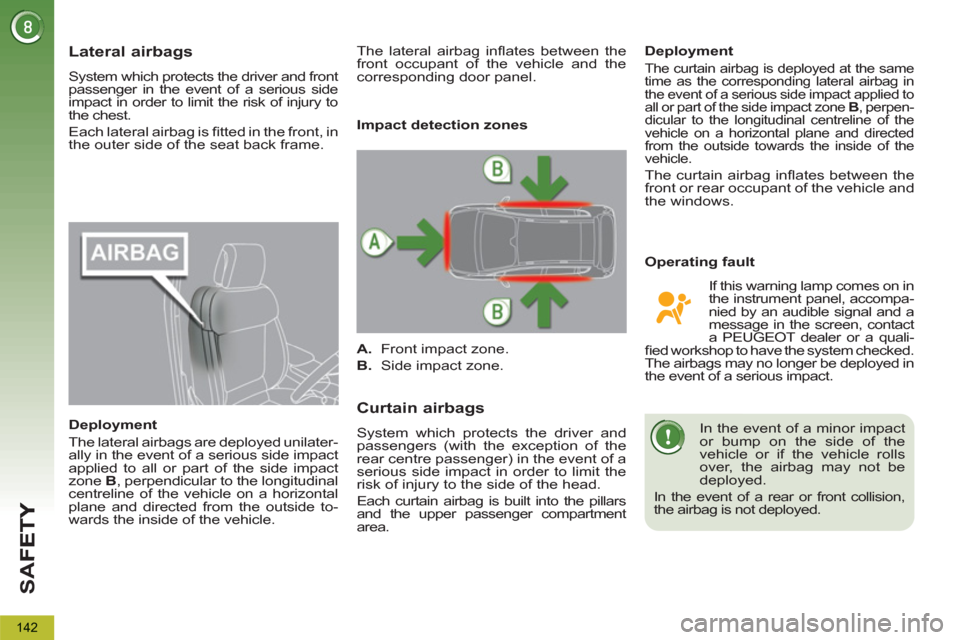
SA
F
142
Lateral airbags
System which protects the driver and front
passenger in the event of a serious side
impact in order to limit the risk of injury to
the chest.
Each lateral airbag is fi tted in the front, in
the outer side of the seat back frame.
Deployment
The lateral airbags are deployed unilater-
ally in the event of a serious side impact
applied to all or part of the side impact
zone B
, perpendicular to the longitudinal
centreline of the vehicle on a horizontal
plane and directed from the outside to-
wards the inside of the vehicle.
Curtain airbags
System which protects the driver and
passengers (with the exception of the
rear centre passenger) in the event of a
serious side impact in order to limit the
risk of injury to the side of the head.
Each curtain airbag is built into the pillars
and the upper passenger compartment
area.
Deployment
The curtain airbag is deployed at the same
time as the corresponding lateral airbag in
the event of a serious side impact applied to
all or part of the side impact zone B
, perpen-
dicular to the longitudinal centreline of the
vehicle on a horizontal plane and directed
from the outside towards the inside of the
vehicle.
The curtain airbag infl ates between the
front or rear occupant of the vehicle and
the windows.
Impact detection zones
A.
Front impact zone.
B.
Side impact zone.
The lateral airbag infl ates between the
front occupant of the vehicle and the
corresponding door panel.
If this warning lamp comes on in
the instrument panel, accompa-
nied by an audible signal and a
message in the screen, contact
a PEUGEOT dealer or a quali-
fi ed workshop to have the system checked.
The airbags may no longer be deployed in
the event of a serious impact.
Operating fault
In the event of a minor impact
or bump on the side of the
vehicle or if the vehicle rolls
over, the airbag may not be
deployed.
In the event of a rear or front collision,
the airbag is not deployed.
Page 146 of 340
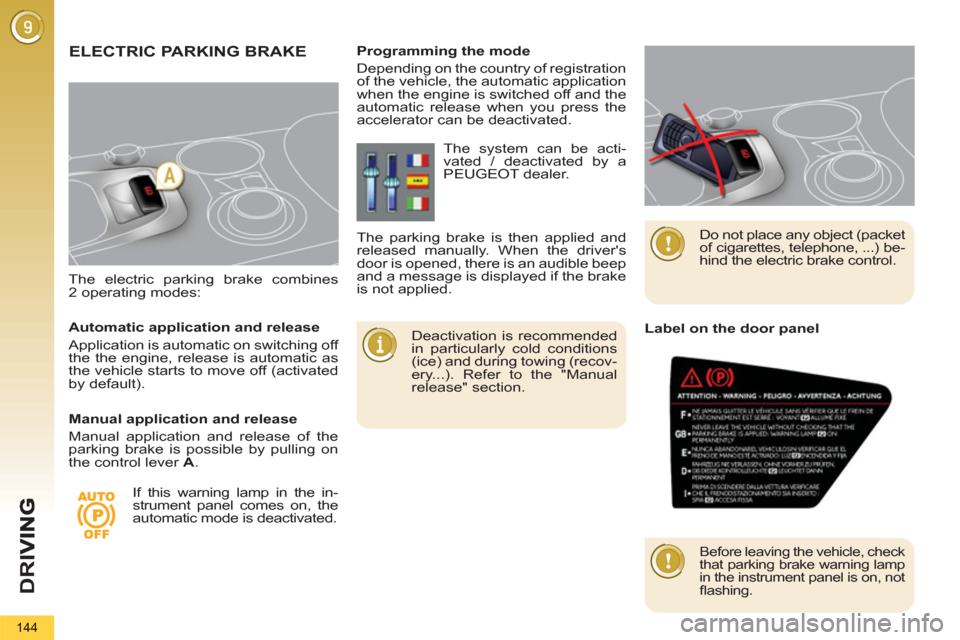
D
R
I
144
The electric parking brake combines
2 operating modes:
ELECTRIC PARKING BRAKE
Deactivation is recommended
in particularly cold conditions
(ice) and during towing (recov-
ery...). Refer to the "Manual
release" section.
Programming the mode
Depending on the country of registration
of the vehicle, the automatic application
when the engine is switched off and the
automatic release when you press the
accelerator can be deactivated.
If this warning lamp in the in-
strument panel comes on, the
automatic mode is deactivated. The system can be acti-
vated / deactivated by a
PEUGEOT dealer.
The parking brake is then applied and
released manually. When the driver's
door is opened, there is an audible beep
and a message is displayed if the brake
is not applied.
Do not place any object (packet
of cigarettes, telephone, ...) be-
hind the electric brake control.
Automatic application and release
Application is automatic on switching off
the the engine, release is automatic as
the vehicle starts to move off (activated
by default).
Manual application and release
Manual application and release of the
parking brake is possible by pulling on
the control lever A
.
Label on the door panel
Before leaving the vehicle, check
that parking brake warning lamp
in the instrument panel is on, not
fl ashing.
Page 147 of 340
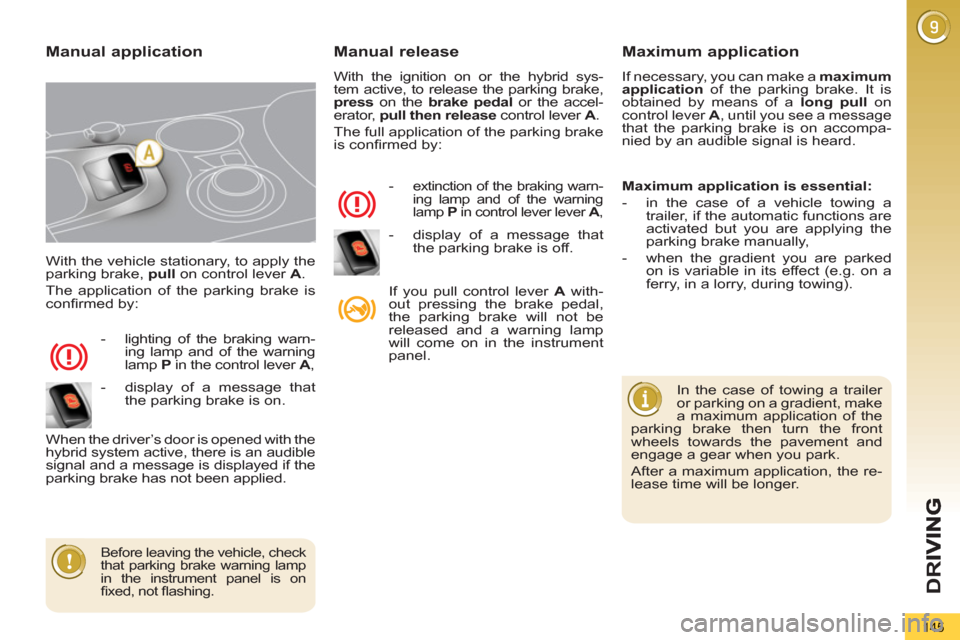
D
R
145
With the vehicle stationary, to apply the
parking brake, pull
on control lever A
.
The application of the parking brake is
confi rmed by:
- lighting of the braking warn-
ing lamp and of the warning
lamp P
in the control lever A
,
When the driver’s door is opened with the
hybrid system active, there is an audible
signal and a message is displayed if the
parking brake has not been applied.
Manual release
With the ignition on or the hybrid sys-
tem active, to release the parking brake,
press
on the brake
pedal
or the accel-
erator, pull then release
control lever A
.
The full application of the parking brake
is confi rmed by:
-
extinction of the braking warn-
ing lamp and of the warning
lamp P
in control lever lever A
,
If you pull control lever A
with-
out pressing the brake pedal,
the parking brake will not be
released and a warning lamp
will come on in the instrument
panel.
Manual applicationMaximum application
If necessary, you can make a maximum
application
of the parking brake. It is
obtained by means of a long pull
on
control lever A
, until you see a message
that the parking brake is on accompa-
nied by an audible signal is heard.
In the case of towing a trailer
or parking on a gradient, make
a maximum application of the
parking brake then turn the front
wheels towards the pavement and
engage a gear when you park.
After a maximum application, the re-
lease time will be longer.
Before leaving the vehicle, check
that parking brake warning lamp
in the instrument panel is on
fi xed, not fl ashing.
Maximum application is essential:
- in the case of a vehicle towing a
trailer, if the automatic functions are
activated but you are applying the
parking brake manually,
- when the gradient you are parked
on is variable in its effect (e.g. on a
ferry, in a lorry, during towing).
- display of a message that
the parking brake is on.
- display of a message that
the parking brake is off.
Page 148 of 340

146
Automatic application,
hybrid system off
With the vehicle stationary, the parking
brake is automatically applied when
the hybrid system is switched off.
- illumination of the braking
warning lamp and of the warn-
ing lamp P
in control lever A
,
Automatic release
The electric parking brake releases auto-
matically and progressively
when you
press the accelerator:
�)
Put the gear lever in position A
, M
or R
then press on the accelerator
pedal.
Before leaving the vehicle,
check that parking brake warn-
ing lamp in the instrument pan-
el is on fi xed (not fl ashing).
Never leave a child alone inside the
vehicle with the ignition on, as they
could release the parking brake.
- extinction of braking warn-
ing lamp and of the warning
lamp P
in the control lever A
,
The noise of operation confi rms the ap-
plication/ release of the electric parking
brake. Full release of the parking brake is con-
fi rmed by:
To immobilise the vehicle,
engine running
With the hybrid system active and the
vehicle stationary, in order to immobil-
ise the vehicle it is essential to manually
apply the parking brake by pulling
on
control lever A
.
The application of the parking brake is
confi rmed by:
- illumination of the braking
warning lamp and of the warn-
ing lamp P
in control lever A
,
When the driver’s door is opened, there
is an audible signal and a message is
displayed if the parking brake has not
been applied.
Before leaving the vehicle, check
that parking brake warning lamp
in the instrument panel is on
fi xed, not fl ashing.
When stationary, with the hybrid
system active, do not press the
accelerator pedal unnecessarily,
as you may release the parking
brake.
Application of the parking brake is con-
fi rmed by:
- display of a message that
the parking brake is on.
In the case of towing, a loaded vehi-
cle or parking on a gradient, turn the
front wheels towards the pavement
and engage a gear when you park.
- display of a message that
the parking brake is off.
- display of a message that
the parking brake is on.
Page 165 of 340
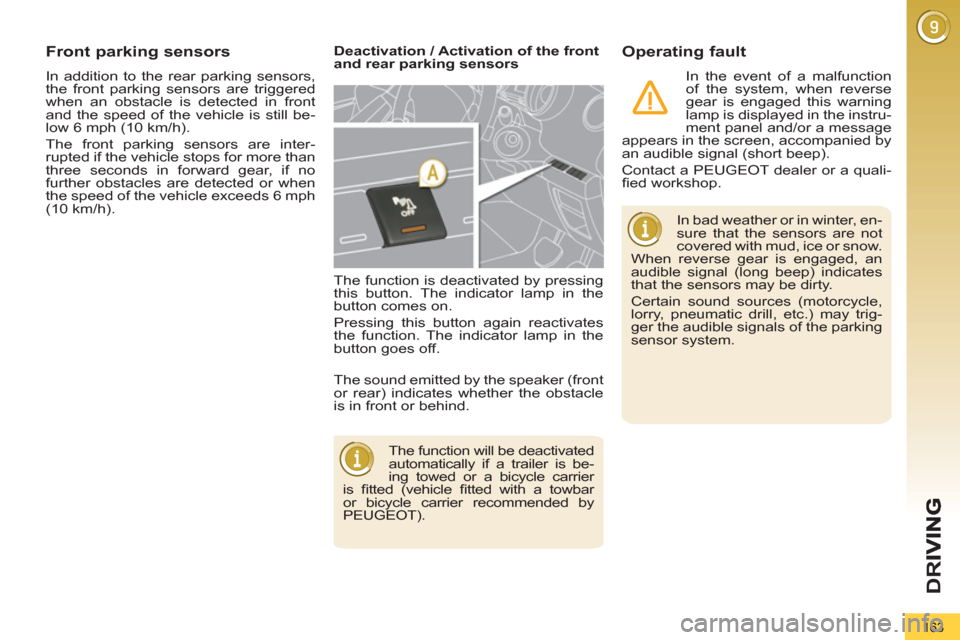
D
R
163
In addition to the rear parking sensors,
the front parking sensors are triggered
when an obstacle is detected in front
and the speed of the vehicle is still be-
low 6 mph (10 km/h).
The front parking sensors are inter-
rupted if the vehicle stops for more than
three seconds in forward gear, if no
further obstacles are detected or when
the speed of the vehicle exceeds 6 mph
(10 km/h).
Front parking sensors
Deactivation / Activation of the front
and rear parking sensors
The function is deactivated by pressing
this button. The indicator lamp in the
button comes on.
Pressing this button again reactivates
the function. The indicator lamp in the
button goes off.
Operating fault
The function will be deactivated
automatically if a trailer is be-
ing towed or a bicycle carrier
is fi tted (vehicle fi tted with a towbar
or bicycle carrier recommended by
PEUGEOT).
In bad weather or in winter, en-
sure that the sensors are not
covered with mud, ice or snow.
When reverse gear is engaged, an
audible signal (long beep) indicates
that the sensors may be dirty.
Certain sound sources (motorcycle,
lorry, pneumatic drill, etc.) may trig-
ger the audible signals of the parking
sensor system.
In the event of a malfunction
of the system, when reverse
gear is engaged this warning
lamp is displayed in the instru-
ment panel and/or a message
appears in the screen, accompanied by
an audible signal (short beep).
Contact a PEUGEOT dealer or a quali-
fi ed workshop.
The sound emitted by the speaker (front
or rear) indicates whether the obstacle
is in front or behind.
Page 173 of 340
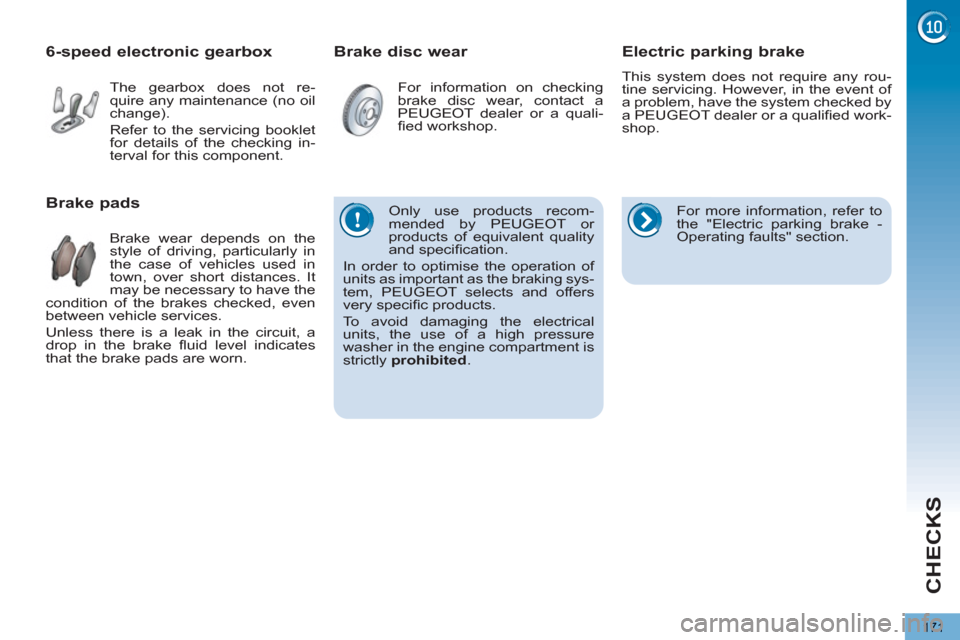
CHECKS
171
Brake disc wear
Brake pads
Brake wear depends on the
style of driving, particularly in
the case of vehicles used in
town, over short distances. It
may be necessary to have the
condition of the brakes checked, even
between vehicle services.
Unless there is a leak in the circuit, a
drop in the brake fl uid level indicates
that the brake pads are worn. For information on checking
brake disc wear, contact a
PEUGEOT dealer or a quali-
fi ed workshop.
6-speed electronic gearbox
The gearbox does not re-
quire any maintenance (no oil
change).
Refer to the servicing booklet
for details of the checking in-
terval for this component.
Electric parking brake
This system does not require any rou-
tine servicing. However, in the event of
a problem, have the system checked by
a PEUGEOT dealer or a qualifi ed work-
shop.
For more information, refer to
the "Electric parking brake -
Operating faults" section.
Only use products recom-
mended by PEUGEOT or
products of equivalent quality
and specifi cation.
In order to optimise the operation of
units as important as the braking sys-
tem, PEUGEOT selects and offers
very specifi c products.
To avoid damaging the electrical
units, the use of a high pressure
washer in the engine compartment is
strictly prohibited
.
Page 174 of 340
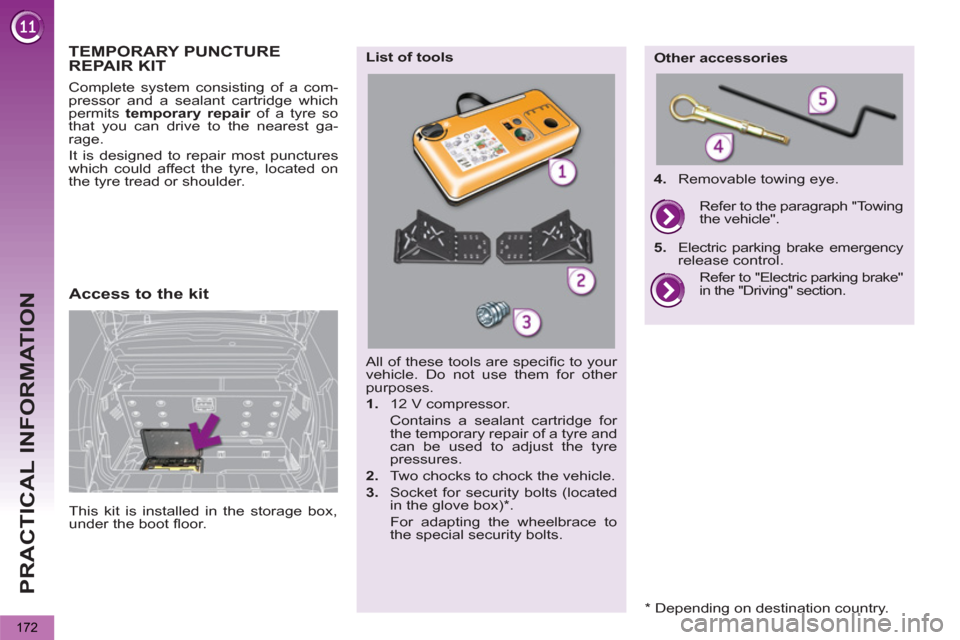
PRACTICAL INFORMATION
172
All of these tools are specifi c to your
vehicle. Do not use them for other
purposes.
1.
12 V compressor.
Contains a sealant cartridge for
the temporary repair of a tyre and
can be used to adjust the tyre
pressures.
2.
Two chocks to chock the vehicle.
3.
Socket for security bolts (located
in the glove box) * .
For adapting the wheelbrace to
the special security bolts.
List of tools
Other accessories
4.
Removable towing eye.
Refer to "Electric parking brake"
in the "Driving" section.
Refer to the paragraph "Towing
the vehicle".
5.
Electric parking brake emergency
release control.
TEMPORARY PUNCTUREREPAIR KIT
Access to the kit
This kit is installed in the storage box,
under the boot fl oor.
*
Depending on destination country.
Complete system consisting of a com-
pressor and a sealant cartridge which
permits temporary repair
of a tyre so
that you can drive to the nearest ga-
rage.
It is designed to repair most punctures
which could affect the tyre, located on
the tyre tread or shoulder.
Page 178 of 340
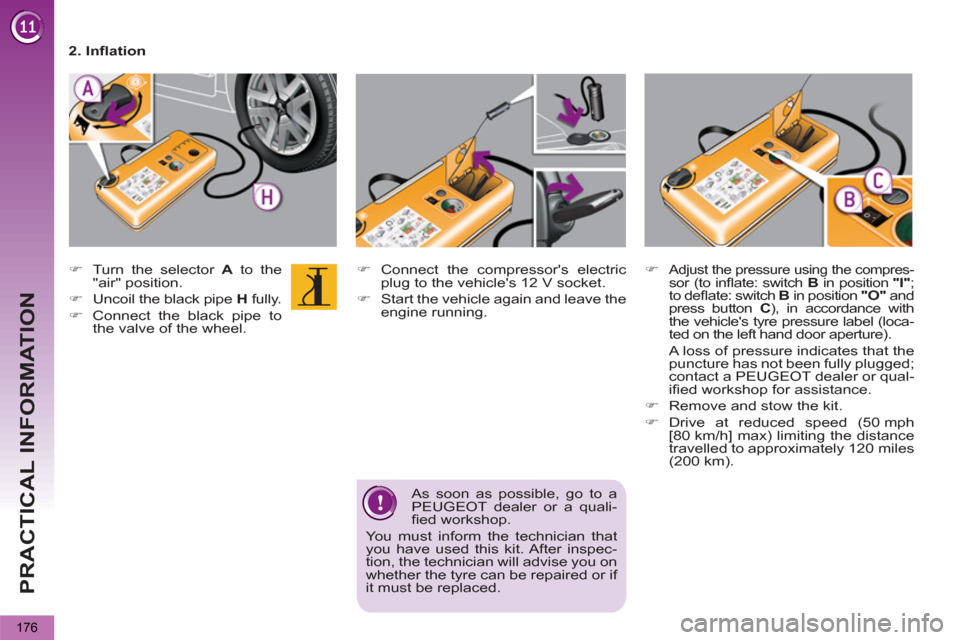
PRACTICAL INFORMATION
176
�)
Connect the compressor's electric
plug to the vehicle's 12 V socket.
�)
Start the vehicle again and leave the
engine running.
�)
Turn the selector A
to the
"air" position.
�)
Uncoil the black pipe H
fully.
�)
Connect the black pipe to
the valve of the wheel.
2. Infl ation
�)
Adjust the pressure using the compres-sor (to infl ate: switch B
in position "I"
;
to defl ate: switch B
in position "O"
and
press button C
), in accordance with
the vehicle's tyre pressure label (loca-
ted on the left hand door aperture).
A loss of pressure indicates that the
puncture has not been fully plugged;
contact a PEUGEOT dealer or qual-
ifi ed workshop for assistance.
�)
Remove and stow the kit.
�)
Drive at reduced speed (50 mph
[80 km/h] max) limiting the distance
travelled to approximately 120 miles
(200 km).
As soon as possible, go to a
PEUGEOT dealer or a quali-
fi ed workshop.
You must inform the technician that
you have used this kit. After inspec-
tion, the technician will advise you on
whether the tyre can be repaired or if
it must be replaced.